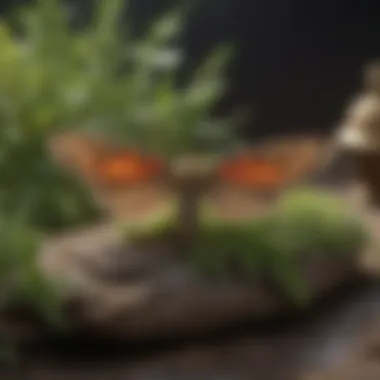Comprehensive Strategies to Eradicate Indian Meal Moths from Your Home


Preventive Pest Control Strategies
When it comes to effectively controlling and preventing Indian meal moths from infesting your home, implementing preventive pest control strategies is paramount. Starting with safeguarding the exterior of your house is a crucial step. Be sure to meticulously seal all cracks and crevices where these pests might find their way in. Additionally, regularly clearing debris around your property will eliminate potential moth breeding grounds. Ensuring a pest-free perimeter will significantly reduce the likelihood of infestations. Taking care of your yard is equally essential. Engage in essential yard maintenance routines such as mowing the lawn regularly, trimming bushes, and removing any decaying plant matter. By keeping your yard well-groomed and free of clutter, you create a less hospitable environment for Indian meal moths and other pests. Indoors, maintaining cleanliness is key to pest prevention. Implement expert cleaning techniques to rid your home of food crumbs and spills that may attract these unwanted insects. Additionally, keeping indoor areas clutter-free and well-ventilated will discourage moth infestations. Proper garbage disposal is another crucial aspect of pest control. Dispose of waste efficiently, ensuring that trash bins are tightly sealed and emptied regularly. By eliminating potential food sources for Indian meal moths, you significantly reduce the risk of an infestation. Exploring innovative ways to safeguard your home further reinforces your pest prevention efforts. Implementing technologies such as ultrasonic pest deterrents or investing in professional pest control services are proactive measures that can help keep Indian meal moths at bay.
Understanding Indian Meal Moths
In the realm of pest control, Indian meal moths hold a notorious reputation for infiltrating homes and contaminating food supplies. Understanding Indian meal moths is crucial for effective eradication strategies and long-term prevention measures. By delving into the nuances of their behavior and lifecycle, homeowners can equip themselves with the knowledge needed to combat these persistent pests. This section will explore key insights into the habits and characteristics of Indian meal moths, shedding light on how their presence can be identified and addressed.
Identifying Indian Meal Moths
Appearance of Indian Meal Moths
When it comes to identifying Indian meal moths, their distinctive appearance plays a vital role. These pests are characterized by a wingspan of approximately 5/8 to 3/4 inch, showcasing a combination of reddish-brown and copper hues on their forewings. The larvae, on the other hand, appear cream-colored with a darker head. Understanding these physical attributes is essential in differentiating Indian meal moths from other common household insects and in implementing targeted removal methods.
Common Infestation Areas
Indian meal moths tend to congregate in areas where food is stored, particularly in pantries, cabinets, and other spaces housing grains and cereals. Common infestation sites also include pet food containers, birdseed bags, and dried fruits. By recognizing these favored habitats, homeowners can streamline their inspection processes and deploy interventions with precision.
Signs of Infestation
The presence of Indian meal moths can be detected through various telltale signs, such as the sighting of adult moths flying erratically in the vicinity of food storage areas. Additionally, silk webbing in food products, larval casings, and fecal matter are indicative of an infestation. Recognizing these signals early on is pivotal in initiating prompt eradication measures to prevent further proliferation.
Lifecycle of Indian Meal Moths
Egg Stage


The commencement of the Indian meal moth lifecycle begins with the egg stage, where female moths lay eggs near food sources. These tiny, oval-shaped eggs are often laid in clusters and hatch within a week under optimal conditions. Understanding this stage aids in intercepting the moth population before it expands exponentially.
Larval Stage
Following the egg stage, Indian meal moth larvae emerge, typically feeding on stored foodstuffs. Their voracious appetite leads to contamination and spoilage of products. Identifying larvae during this stage is critical for implementing targeted control strategies to mitigate damage and curb infestations.
Pupal Stage
During the pupal stage, larvae transition into pupae within silken cocoons, where they undergo metamorphosis to develop into adult moths. This transitional phase signifies a pivotal moment in the life cycle of Indian meal moths, marking the eventual emergence of the next generation of pests.
Adult Moth
The adult stage of Indian meal moths is characterized by reproductive activity, with female moths laying eggs to perpetuate the lifecycle. Their aerial presence near food sources accentuates the urgency of effectively managing infestations to thwart the proliferation of these pests and safeguard stored provisions from contamination.
Preventive Measures
In combating Indian meal moth infestations, preventive measures play a crucial role in ensuring long-term eradication. By proactively addressing factors that attract these pests, you can significantly reduce the likelihood of infestations reoccurring. Maintaining Cleanliness is a fundamental aspect of preventive measures. This includes implementing Storage Practices that involve storing food items in airtight containers to prevent access for Indian meal moths. The key characteristic of Storage Practices lies in the meticulous organization of your pantry and kitchen storage areas, reducing potential hiding spots for these pests. Keeping a Regular Cleaning Routine is equally vital. This routine involves thorough cleaning of food storage areas, eliminating any food particles that may attract Indian meal moths.
Sealing Entry Points serves as an additional layer of defense against these pests. Identifying Potential Entryways such as gaps in doors or windows allows you to target areas where Indian meal moths may enter your home. By understanding the unique features of Identifying Potential Entryways, you can take proactive steps to seal these entry points effectively, minimizing the chance of infestations. Sealing Cracks and Gaps is a popular method for preventing Indian meal moths from accessing your stored food. The key characteristic of this technique lies in its ability to close off common entry points, creating a barrier that deters these pests.
When focusing on Proper Food Storage, utilizing Airtight Containers becomes essential. These containers offer a secure storage solution that prevents Indian meal moths from infesting your food supplies. The key characteristic of Airtight Containers is their ability to seal food items completely, eliminating access for pests. Monitoring Food Freshness is equally important, ensuring that you discard expired food promptly to prevent attracting Indian meal moths. This practice involves regularly checking the freshness of stored food and disposing of any items that show signs of spoilage.
Eradication Techniques
Eradication techniques play a crucial role in addressing Indian meal moth infestations effectively, safeguarding your living space from these persistent pests. In this section, we will delve into the specific elements, benefits, and considerations surrounding eradication techniques to provide a comprehensive guide on combating these unwanted intruders.
Natural Remedies


Herbs and Essential Oils
Herbs and essential oils serve as potent allies in the battle against Indian meal moths. Their natural properties not only help repel moths but also disrupt their life cycle, preventing reinfestation. The key characteristic of herbs and essential oils lies in their ability to deter moths without harmful chemicals, making them a popular choice for eco-conscious individuals looking to eliminate pests without compromising environmental wellbeing. These natural remedies offer a unique feature of emitting scents that repel moths while being safe for use around food and family. However, it's important to note that their effectiveness may vary, requiring consistent application for optimal results.
Traps and Lures
Utilizing traps and lures is a strategic approach to lure and capture Indian meal moths within your home. These tools work by attracting adult moths towards them, subsequently trapping them and preventing further reproduction. The key characteristic of traps and lures is their ability to monitor moth activity, aiding in the early detection of infestations. This method is beneficial for those seeking a non-toxic solution to moth issues and can be conveniently placed in susceptible areas. However, their unique feature of passive trapping may require multiple traps for comprehensive coverage, necessitating vigilance in deployment.
Chemical Treatments
Insecticides
Insecticides offer a targeted and potent solution to combat Indian meal moths effectively. Their key characteristic lies in their fast-acting formulation, swiftly eliminating moth populations upon contact. This popular choice for eradication provides immediate relief from infestations, especially in severe cases. Their unique feature of residual effectiveness ensures continued protection against future infestations; however, it's essential to consider the potential environmental impact and proper application to mitigate risks.
Professional Pest Control
Opting for professional pest control services guarantees a comprehensive approach to eradicating Indian meal moths from your home. The key characteristic of professional pest control lies in the expertise and resources they bring to tackle even the most stubborn infestations. This beneficial choice offers a tailored solution to your specific moth problem, ensuring thorough removal and prevention strategies. Their unique feature of ongoing monitoring and maintenance provides peace of mind against future infestations, although the cost and reliance on external services are important considerations to weigh.
Persistent Infestation Solutions
In addressing the Persistent Infestation Solutions in this comprehensive guide on combating Indian meal moths, it is crucial to understand the critical role these solutions play in effectively eradicating and preventing infestations. When facing persistent infestations, deep cleaning techniques become imperative to ensure a thorough elimination of these pests from your living space. By delving into specific elements of Persistent Infestation Solutions, such as deep cleaning methods and expert consultations, homeowners can safeguard their homes effectively.
Deep Cleaning Techniques
Thorough Inspection


In the battle against Indian meal moths infestations, a Thorough Inspection stands out as a fundamental step towards identifying the source and extent of the infestation. Conducting a comprehensive inspection allows homeowners to pinpoint areas of high activity, such as pantries or storage areas, enabling targeted treatment application. The key characteristic of a Thorough Inspection lies in its meticulous approach, leaving no corner unchecked. Its benefits in this article are clearly evident, as it aids in devising tailored eradication strategies and prevention plans. Despite the thoroughness being time-consuming, the advantages of early detection and precise targeting make it a popular choice for effectively combating Indian meal moth infestations.
Sanitization Procedures
When it comes to Indian meal moth infestations, Sanitization Procedures play a vital role in ensuring a clean and moth-free environment. By implementing thorough sanitization measures post-inspection, homeowners can eliminate any remaining eggs, larvae, or pupae, breaking the life cycle of these pests. The key characteristic of Sanitization Procedures lies in the thorough cleaning and disinfection of infested areas, preventing reinfestation. The unique feature here is the long-lasting impact of sanitization in keeping Indian meal moths at bay. While time-consuming, the advantages of a sanitized environment far outweigh the temporary inconvenience, making it a beneficial choice in this article for maintaining a moth-free home.
Consulting Experts
In complicated cases of persistent Indian meal moth infestations, seeking the expertise of professionals like Entomologists and Professional Exterminators becomes indispensable. These expert consultations offer specialized knowledge and experience in dealing with challenging infestation scenarios, elevating the effectiveness of eradication efforts significantly. Entomologists bring a deep understanding of insect behavior and biology to the table, aiding in the development of targeted treatment plans. Their unique feature lies in their ability to provide tailored solutions based on specific infestation characteristics, ensuring effective results. While the cost of consulting experts might be a consideration, the advantages of swift and precise eradication should not be overlooked, making them a popular choice for homeowners grappling with persistent infestations. Professional Exterminators, on the other hand, bring in-depth knowledge of pest control techniques and access to specialized products not available to the general public. Their key characteristic lies in their ability to execute eradication plans efficiently and effectively, offering long-term solutions to Indian meal moth infestations. While the cost of professional services might be higher, the advantages of guaranteed results and ongoing support make them a valuable choice in this article for combating persistent infestations.
Maintaining a Moth-Free Environment
Maintaining a moth-free environment is crucial in the battle against Indian meal moth infestations within your home. To effectively address this issue, it is essential to establish stringent practices that target the prevention of further moth invasions. By upholding a home environment that is inhospitable to these pests, you can significantly reduce the likelihood of recurring infestations, safeguarding your living space and food storage areas.
Regular Monitoring
Routine Checks
Routine checks are a fundamental aspect of maintaining a moth-free environment. Regular inspections of food storage areas, pantry shelves, and other potential moth dwelling spots enable early identification of any signs of infestation. This proactive approach allows for swift intervention, preventing the escalation of moth problems. Routine checks involve thorough and systematic examination, ensuring no corner is left unchecked for potential moth activity.
Early Detection
Early detection plays a pivotal role in the effectiveness of moth control measures. By promptly spotting the initial signs of Indian meal moth presence, such as tiny larvae or webbing in food packages, you can take immediate action to eliminate the threat. Early detection contributes to reducing the extent of infestation, minimizes food spoilage, and aids in maintaining a hygienic living environment. Implementing strategies for early detection ensures quick responses to any emerging moth issues.
Sustainable Practices
Integrated Pest Management
Integrated Pest Management (IPM) is a holistic approach to pest control that involves utilizing multiple strategies to manage and prevent infestations. This method focuses on long-term solutions that are environmentally sensitive and effective. Implementing IPM involves identifying the root causes of moth problems, implementing preventive measures, and using targeted treatments when necessary. IPM promotes a balanced ecosystem within your home, minimizing the reliance on harmful chemicals for pest control.
Environmentally-Friendly Solutions
Utilizing environmentally-friendly solutions is paramount in promoting a safe and sustainable living environment. Opting for non-toxic methods of moth control, such as pheromone traps or natural repellents, helps in safeguarding both your health and the ecosystem. Environmentally-friendly solutions are gentle yet effective, offering a green alternative to traditional chemical treatments. By choosing sustainable practices, you contribute to creating a healthier living space for your family and the environment.



